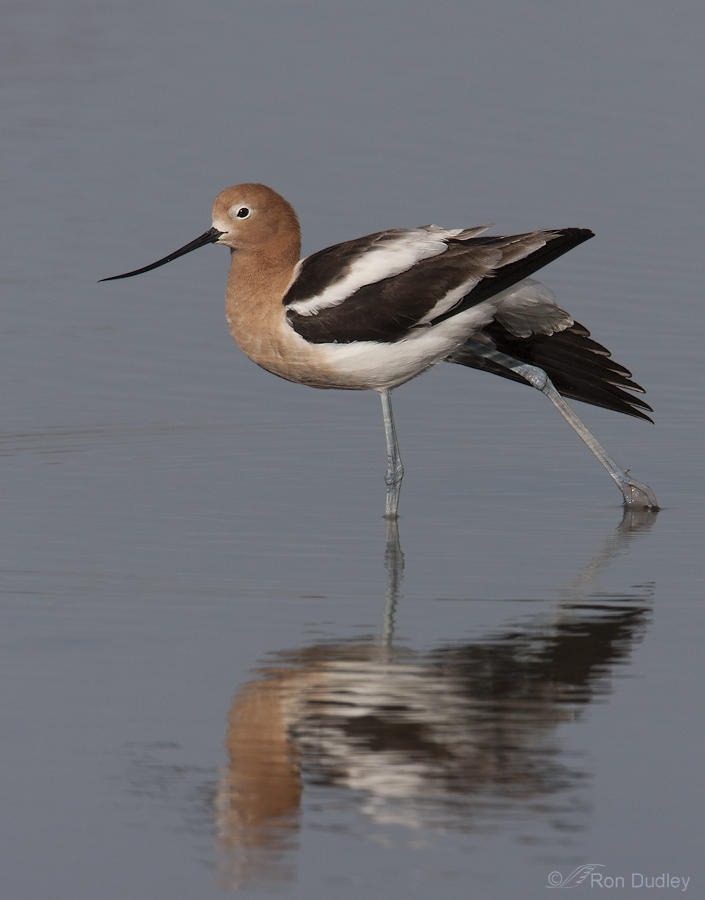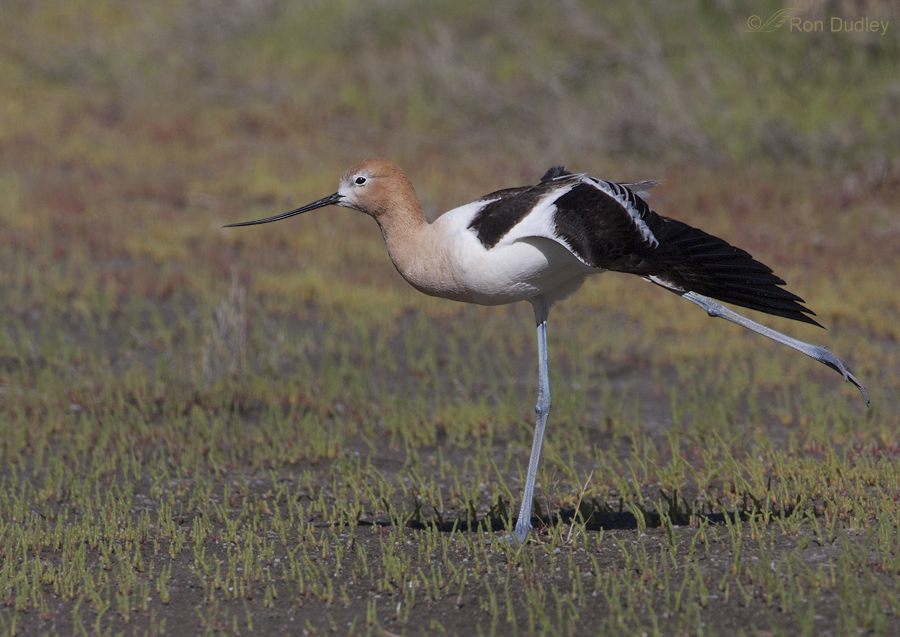Anticipating behaviors is often crucial for nature photographers and that’s particularly true when your subject is a lightning-fast bird. Most of us don’t need any more images where the wings have been cut off in the frame or the bird is soft due to lack of shutter speed or poor focus tracking of the bird at take-off.
The American Avocet in breeding plumage is an especially lovely subject with its long recurved bill, bluish legs, cinnamon head and neck and the black and white chevron pattern on its back. But you don’t see many quality flight or take-off images of the species, partially because their flight tendencies are fast and erratic.
Like many birds, avocets routinely perform single wing and leg stretches. These stretches occur when the bird is at rest and at ease. They stretch like this in the water…
and on land. But this single-wing/leg stretch is not an indicator of nervousness or a precursor of take-off. Neither of the birds in these two images did so immediately after the stretch.
1/1000, f/8, ISO 500, 500 f/4, 1.4 tc, natural light, a sliver of canvas added for composition
But when you see this two-winged wing stretch, expect imminent take-off. A few seconds later this bird did just that but it took off away from me and I deleted the images.
Another two-wing stretch. And almost immediately after the wings came down…
the bird took off. It’s not a good shot because of the angle of take-off but it illustrates my point.
Here’s what Birds of North America Online has to say on the subject:
“Two-wing stretch generally performed after resting and before period of flying, resting, or preening; most frequently performed by disturbed birds. Two-wing stretch often appears to be preflight intention movement; in contrast, wing and leg stretches are associated only with resting.”
I suspect they stretch like this to loosen up the wing muscles for flight after a period of inactivity, much like a human athlete does before an event. If you’re a bird photographer it can be a productive behavior to understand for obvious reasons. But if you simply like to watch birds, understanding the potential meaning of behaviors like this can make your time in the field even more enjoyable.
Ron







Ron!
Look at the eye in the “take-off” shot, and compare with the other shots. This is a great example of being “wide-eyed”.
These shots also show the bill difference in male and female, with the female having a more pronounced bend.
All these details brings me closer to the birds’ world, and I love that.
Thank You! again,
Sue
You’re right about the eye at take-off, Sue. I’d be wide-eyed too if I took off at the speed they do.
Great post Ron! I love your inclusion and discussion of behavior. I’ve never noticed this behavior, but I’ll certainly begin watching for it!
It’s a pretty reliable indicator of take-off, Bryce. Doesn’t work every time but it very often does.
How wonderful! I have been lusting after an avocet to shoot, but could not find one. This is certainly the next best thing. My photos would pale by comparison to yours anyway. Nice to know about the behavior so that when I do encounter one, I will be warned of take off.
Thanks so much!
Male a spring/summer visit to Utah, Charlotte. We have oodles of them then.
What a fascinating bird, and such a bonus to photography when a behaviour is better understood. I imagine that without this piece of knowledge you would miss take-offs a great deal more often than not.
Off topic here. A friend sent me a youtube video of a Sage Grouse. Do you ever see them?
Elephant’s Child, I’ve seen them a few times but not often and I don’t yet have any images of them. They’re very large and when one flushes unexpectedly right in front of you it gets your attention, believe me!
Ron, your photography is exquisite! And I do love that you take the time to explain the process that you go through to get your shots.
Thanks, Kathryn. I’m glad you find the explanations useful.
Ron, good tip! I usually take the pictures of the “resting” stretches and miss the take-offs. I’ll pay more attention to the two-wing stretch now!
I often miss the take-offs too, Wally. But knowing this stuff improves our chances significantly.
Thank you, Laval and Len.
As usual wonderful pictures and interesting information.
Thank you.
Len
Hi Ron,
What a nice bird and an informative blog ! It’s true that you must know your subject if you want to get photos showing their behavior. It’s not a question of chance. My prefered shot is the third one. Up here, in Quebec, this bird is a rarity, not seen every year, and never wearing the colourful plumage shown here. Thanks for sharing again your experience.